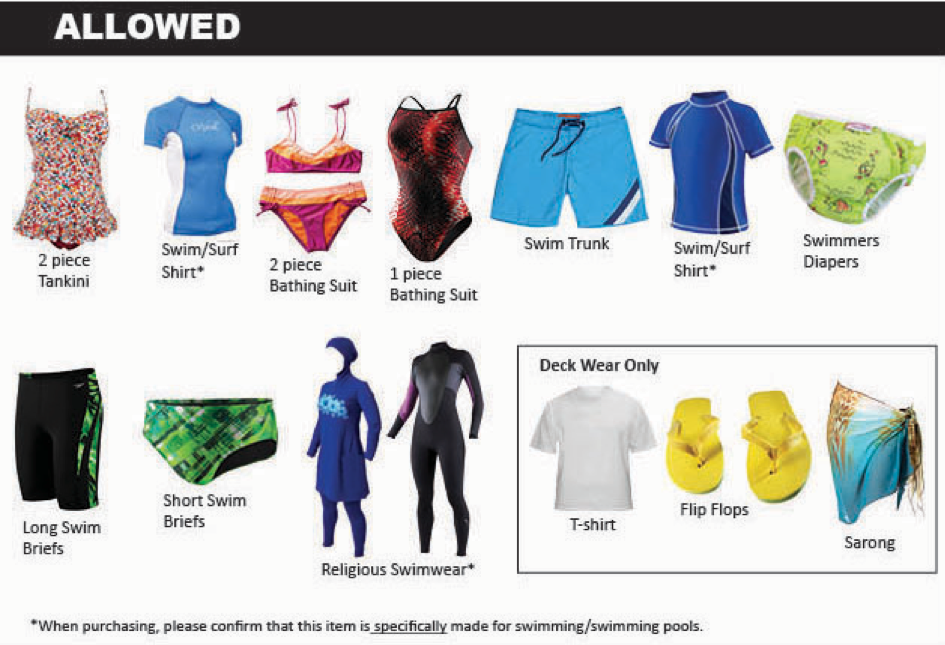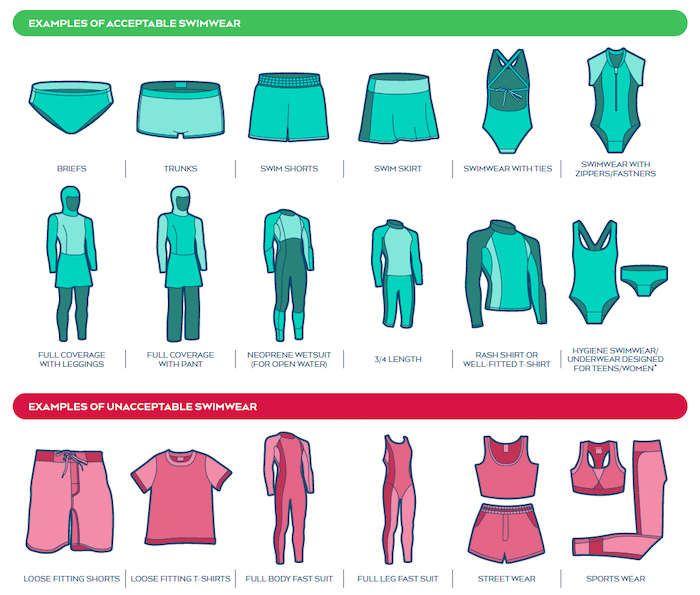Content Menu
● Types of Swimwear
● Current Swimwear Trends
● Guidelines for Acceptable Swimwear
>> 1. Material Matters
>> 2. Fit and Functionality
>> 3. Local Regulations
● What Not to Wear
● Choosing the Right Swimwear for Different Activities
>> Casual Swimming
>> Competitive Swimming
● Cultural Considerations
● The Evolution of Swimwear
>> Historical Context
● Choosing Swimwear Based on Body Type
>> Pear-Shaped Body
>> Hourglass Body
>> Athletic Body
>> Apple-Shaped Body
>> Petite Body
● The Importance of Comfort and Confidence
● Conclusion
● Related Questions & Answers
>> 1. What types of swimwear are best for competitive swimming?
>> 2. Are burkinis accepted at all public pools?
>> 3. Can I wear leggings over my swimsuit?
>> 4. What materials should I avoid in swimwear?
>> 5. Is there a difference between swim briefs and regular underwear?
● Citations:
Swimwear has evolved significantly over the years, reflecting changes in fashion, culture, and societal norms. When it comes to choosing swimwear, women have a variety of options that cater to different preferences, body types, and activities. This article will explore the types of swimwear that are generally considered acceptable for women in various settings, including public pools, beaches, and competitive swimming environments.
Types of Swimwear
Understanding the different styles of swimwear is crucial for making an informed choice. Here are some of the most common types:
- One-Piece Swimsuits: These are often favored for their practicality and support. They provide full coverage and are suitable for various swimming activities.
- Bikinis: A popular choice for beach outings, bikinis come in various styles and cuts. However, acceptance can vary by location.
- Tankinis: This two-piece option features a longer top that provides more coverage than traditional bikinis while still allowing for ease of movement.
- Skirted Swimsuits: These combine the benefits of a one-piece with a skirted bottom for added modesty.
- Swim Shorts: Often paired with a tankini or bikini top, swim shorts offer comfort and coverage.
- Burkinis: Designed for modesty, burkinis cover the body while still being suitable for swimming. Acceptance varies by facility.

Current Swimwear Trends
The swimwear landscape is continually changing, influenced by fashion trends and consumer preferences. Here are some notable trends for 2024:
- Embellished Swimsuits: Textured swimsuits featuring luxe embroidery and crochet designs are gaining popularity. These pieces can transition from beach to dinner effortlessly.
- Strapless One-Pieces: Minimalist designs with contrasting colors and unexpected cutouts are trendy this season, offering a chic yet comfortable option.
- Retro Styles: High-waisted cuts and cheeky silhouettes reminiscent of the 90s are making a comeback, allowing for endless mix-and-match possibilities.
- Sustainable Swimwear: With increasing awareness of environmental issues, many brands are adopting sustainable practices by using eco-friendly materials and production methods.
- Bold Prints and Colors: From floral patterns to animal prints like zebra stripes, bold designs are in vogue this summer.
Guidelines for Acceptable Swimwear
When selecting swimwear, it's essential to consider both comfort and adherence to local regulations. Here are some general guidelines:
1. Material Matters
Swimwear should be made from materials that are suitable for water activities. Fabrics like Lycra and nylon are preferred because they are less absorbent and won't clog pool filters. Avoid heavy materials such as cotton or denim that can become waterlogged.
2. Fit and Functionality
Swimwear should fit snugly without being overly tight or baggy. Loose clothing can hinder movement and may pose safety risks in water environments.
3. Local Regulations
Different pools and beaches have specific rules regarding acceptable swimwear. It's important to check these regulations before heading out:
- Many public pools require one-piece swimsuits or tankinis.
- Bikinis may be restricted in certain facilities due to modesty policies.
- Burkinis are increasingly accepted in many establishments but may still face restrictions in others.
What Not to Wear
Certain types of clothing are typically prohibited in swimming facilities due to safety and hygiene concerns:
- Street Clothes: Items like jeans, skirts, or athletic shorts are not suitable as they can introduce contaminants into the water.
- Baggy Clothing: Loose garments can become cumbersome when wet and may pose a drowning risk.
- Underwear: Regular underwear is not permitted under swimsuits as it does not provide adequate support or coverage.

Choosing the Right Swimwear for Different Activities
Depending on your intended activity—whether it's casual swimming, competitive racing, or sunbathing—your swimwear choice may vary significantly.
Casual Swimming
For leisurely swims at the beach or pool:
- One-piece swimsuits or tankinis offer comfort and support.
- Bikinis can be a stylish option but ensure they meet local guidelines.
Competitive Swimming
Competitive swimmers often require specialized swimwear that enhances performance:
- High-performance one-piece suits made from chlorine-resistant materials are ideal.
- Some swimmers opt for full-body suits which provide additional buoyancy and speed.
Cultural Considerations
Cultural norms play a significant role in determining what is considered acceptable swimwear. In some cultures, modesty is paramount, leading to preferences for burkinis or full-coverage swimsuits. Understanding these cultural differences is crucial when choosing swimwear for travel or public swimming areas.
The Evolution of Swimwear
Historically, women's swimwear has undergone significant changes influenced by fashion trends and societal attitudes towards modesty. In the early 20th century, women were required to wear full-body suits with stockings; however, these restrictions have relaxed over time. Today's swimwear reflects greater freedom of expression while still adhering to safety standards in aquatic environments.
Historical Context
The history of women's swimwear dates back to the mid-1800s when improvements in transportation made it easier for people to visit beaches. Early swimsuits were designed with modesty in mind; they resembled dresses made from heavy fabrics that provided full coverage but were impractical for swimming.
In 1907, Australian swimmer Annette Kellerman caused a scandal by wearing a one-piece bathing suit that revealed her arms and legs during a demonstration in Boston. This event marked a turning point in swimwear design as it challenged societal norms about women's bodies in public spaces[2][3].
By the 1920s, swimsuits became smaller as Hollywood glamorized beach culture. The introduction of synthetic fabrics allowed designers to create more form-fitting styles that emphasized femininity[7]. The bikini was introduced in 1946 by designer Louis Réard but did not gain widespread acceptance until the 1950s[2].
Choosing Swimwear Based on Body Type
Finding the perfect swimsuit involves understanding your body type and selecting styles that flatter your unique features:
Pear-Shaped Body
If you have a pear-shaped body characterized by narrower shoulders and wider hips:
- Look for tops with embellishments or bright colors to draw attention upwards.
- High-cut bottoms can help elongate your legs.
Hourglass Body
For those with an hourglass figure:
- Highlight your curves with belted one-pieces or high-waisted bikinis.
- Avoid overly complicated patterns that might overwhelm your shape.
Athletic Body
If you have an athletic build with broader shoulders:
- Opt for padded bikini tops or swimsuits with ruffles to create curves.
- Monokinis can also add interest while providing coverage.
Apple-Shaped Body
For an apple-shaped figure where weight is carried around the midsection:
- Choose swimsuits with ruching or draping to camouflage your midsection.
- High-waisted bottoms can provide tummy control while enhancing your silhouette.
Petite Body
If you have a petite frame:
- High-cut bottoms will help elongate your legs.
- Avoid oversized prints that can overwhelm your small frame.
The Importance of Comfort and Confidence
Ultimately, the best swimwear allows you to feel confident while enjoying water activities. It's essential to try on various styles to find what makes you feel comfortable and beautiful. Remember that trends come and go; what matters most is how you feel in your swimsuit.
Conclusion
Choosing acceptable swimwear involves understanding personal preferences alongside local regulations and cultural considerations. Whether opting for a one-piece swimsuit for its practicality or a bikini for its style, women now have more choices than ever before when it comes to enjoying water activities confidently.
Related Questions & Answers
1. What types of swimwear are best for competitive swimming?
- High-performance one-piece swimsuits made from chlorine-resistant materials are ideal for competitive swimmers due to their streamlined fit.
2. Are burkinis accepted at all public pools?
- Acceptance of burkinis varies by facility; some pools embrace them while others may have restrictions based on hygiene policies.
3. Can I wear leggings over my swimsuit?
- Leggings are generally not allowed over swimsuits in most pools due to safety concerns; however, fitted leggings under swim shorts may be acceptable.
4. What materials should I avoid in swimwear?
- Avoid heavy materials like denim or cotton as they can become waterlogged and introduce contaminants into the pool.
5. Is there a difference between swim briefs and regular underwear?
- Yes, swim briefs are designed specifically for water use with appropriate materials that do not absorb water like regular underwear does.
Citations:
[1] https://www.vogue.com/article/swimsuit-trends
[2] https://historicedmonds.org/unveiling-the-unexhibited-womens-swimwear/
[3] https://fashionhistory.fitnyc.edu/a-history-of-womens-swimwear/
[4] https://swimco.com/blogs/news/choosing-the-perfect-swimwear-style-for-your-body-type
[5] https://www.cosmopolitan.com/uk/fashion/style/g60500540/best-swimwear-brands/
[6] https://www.bikinivillage.com/en/featured/swimsuit-trends-2024
[7] https://en.wikipedia.org/wiki/History_of_swimwear
[8] https://artsandculture.google.com/story/the-radical-history-of-the-swimsuit/CwWRYuCmuuxYLg?hl=en
[9] https://www.simplyswim.com/blogs/blog/the-ultimate-guide-to-choosing-the-perfect-swimsuit-for-your-body-type
[10] https://www.elle.com/fashion/trend-reports/a46978359/2024-swimwear-trends/

































































